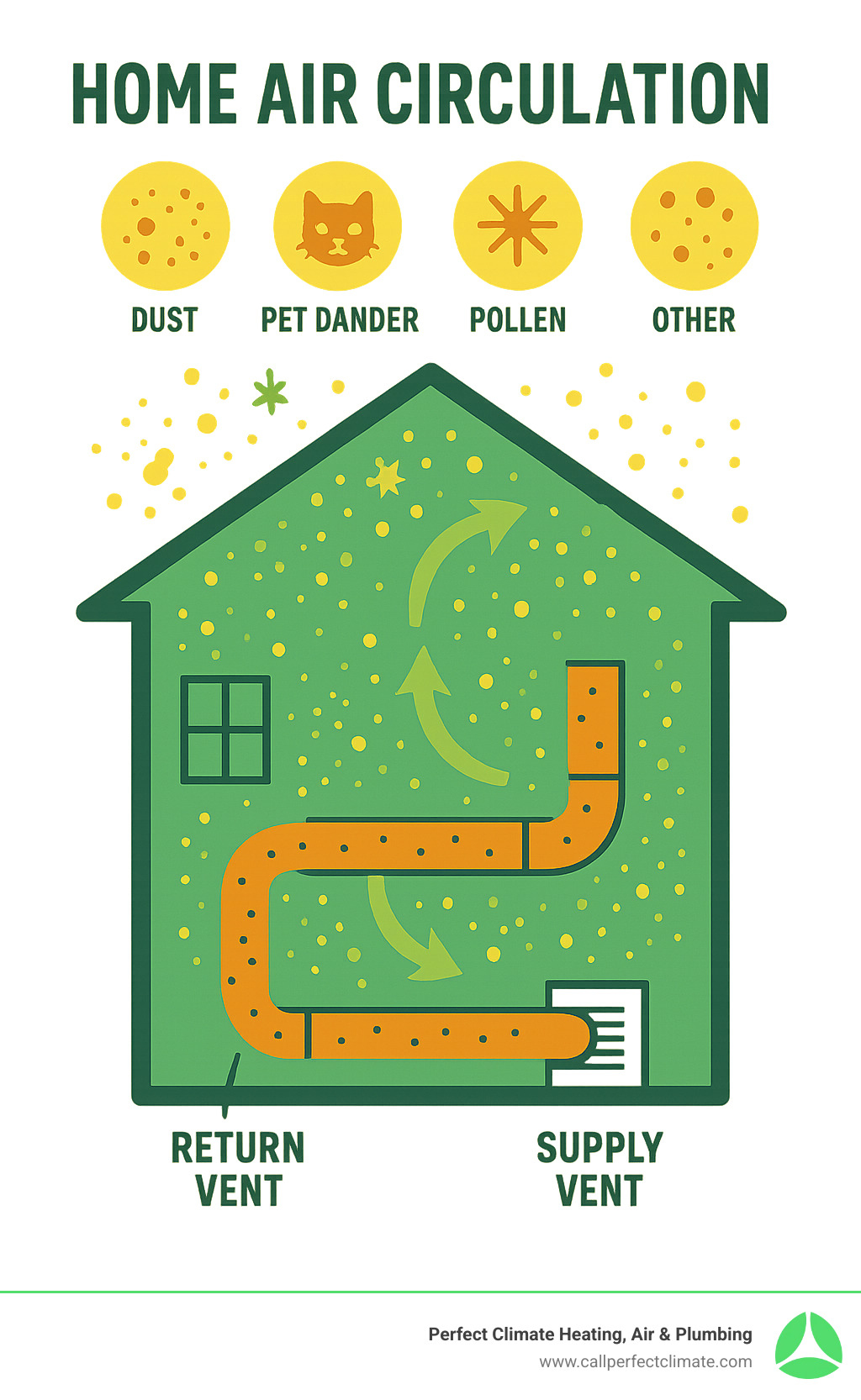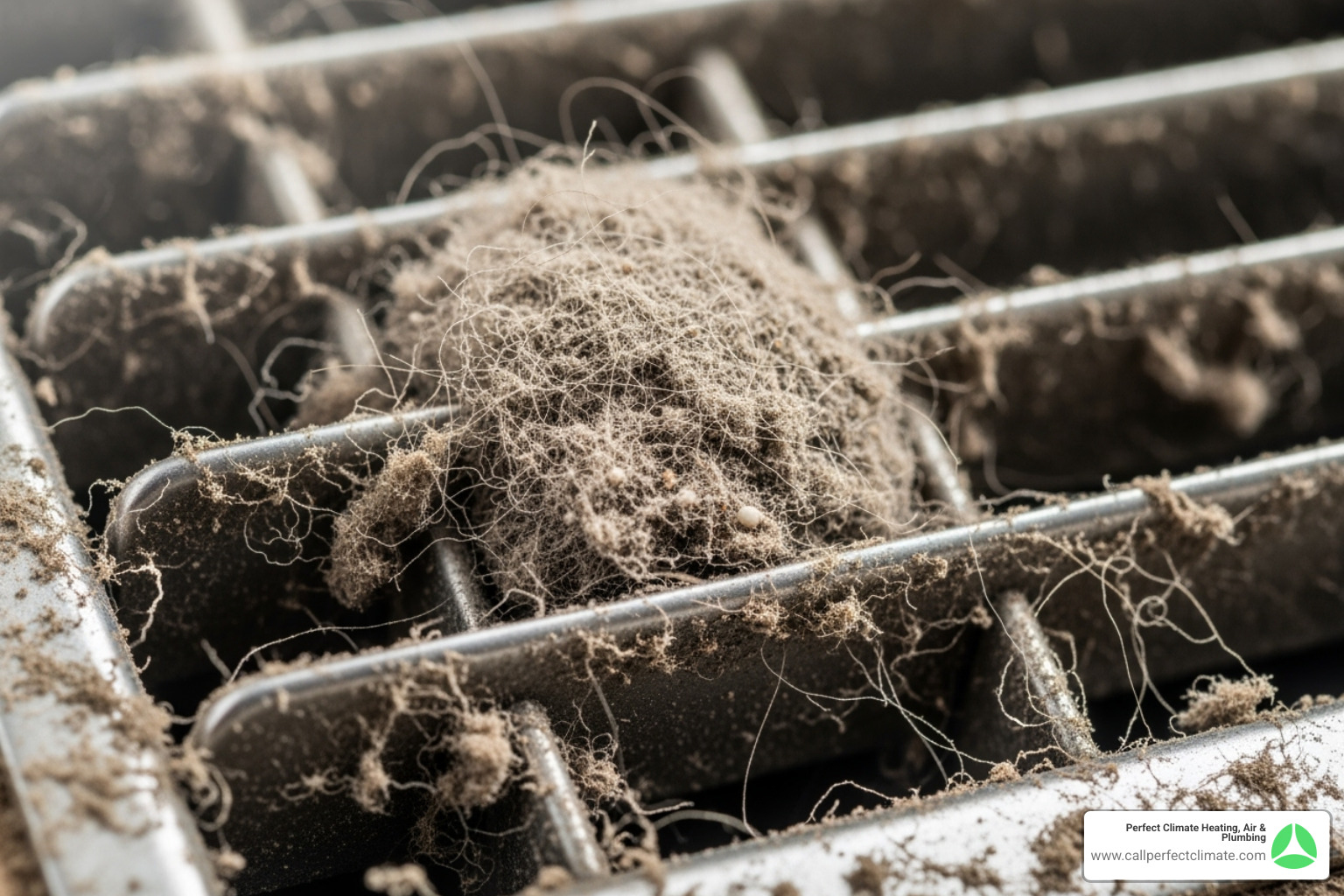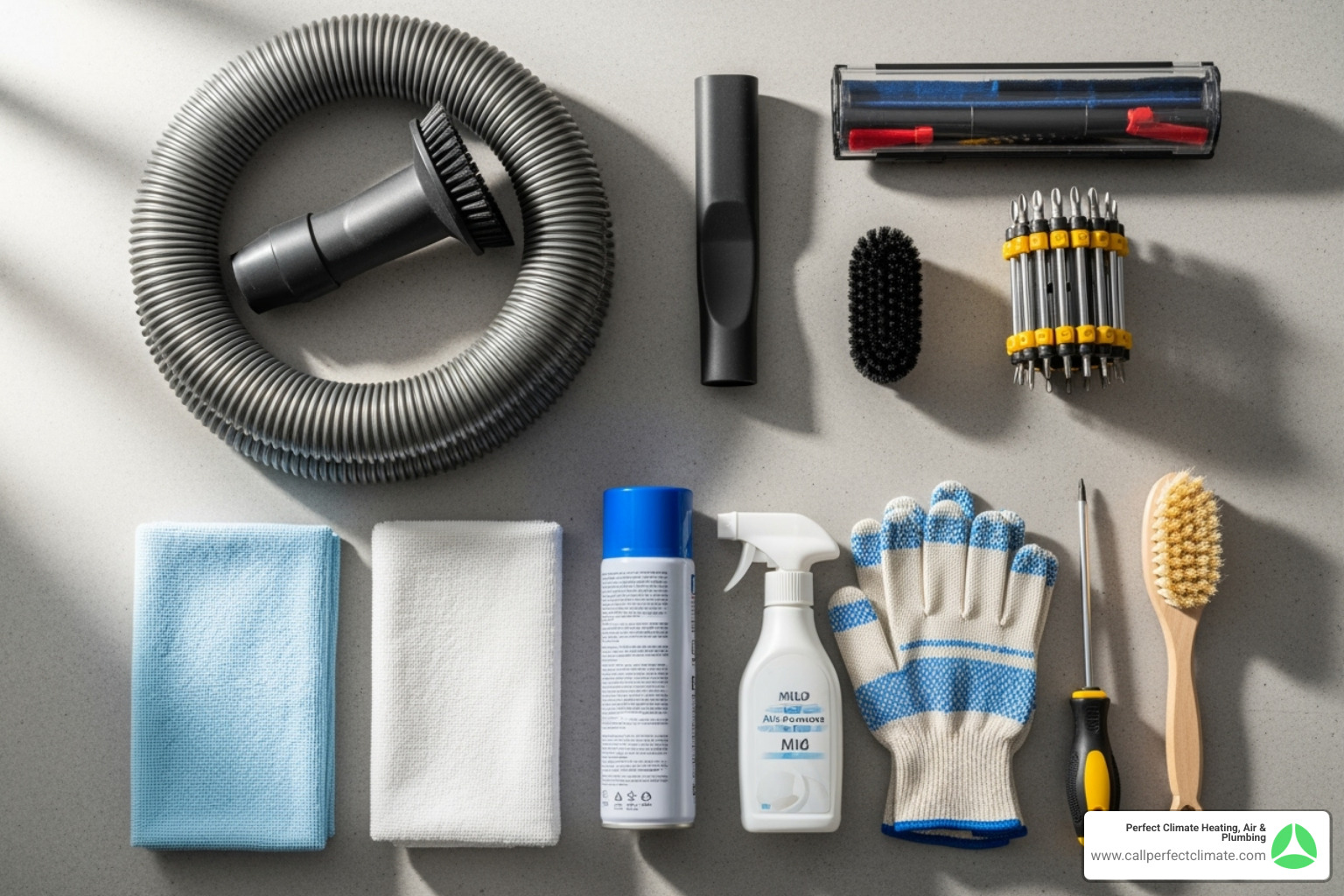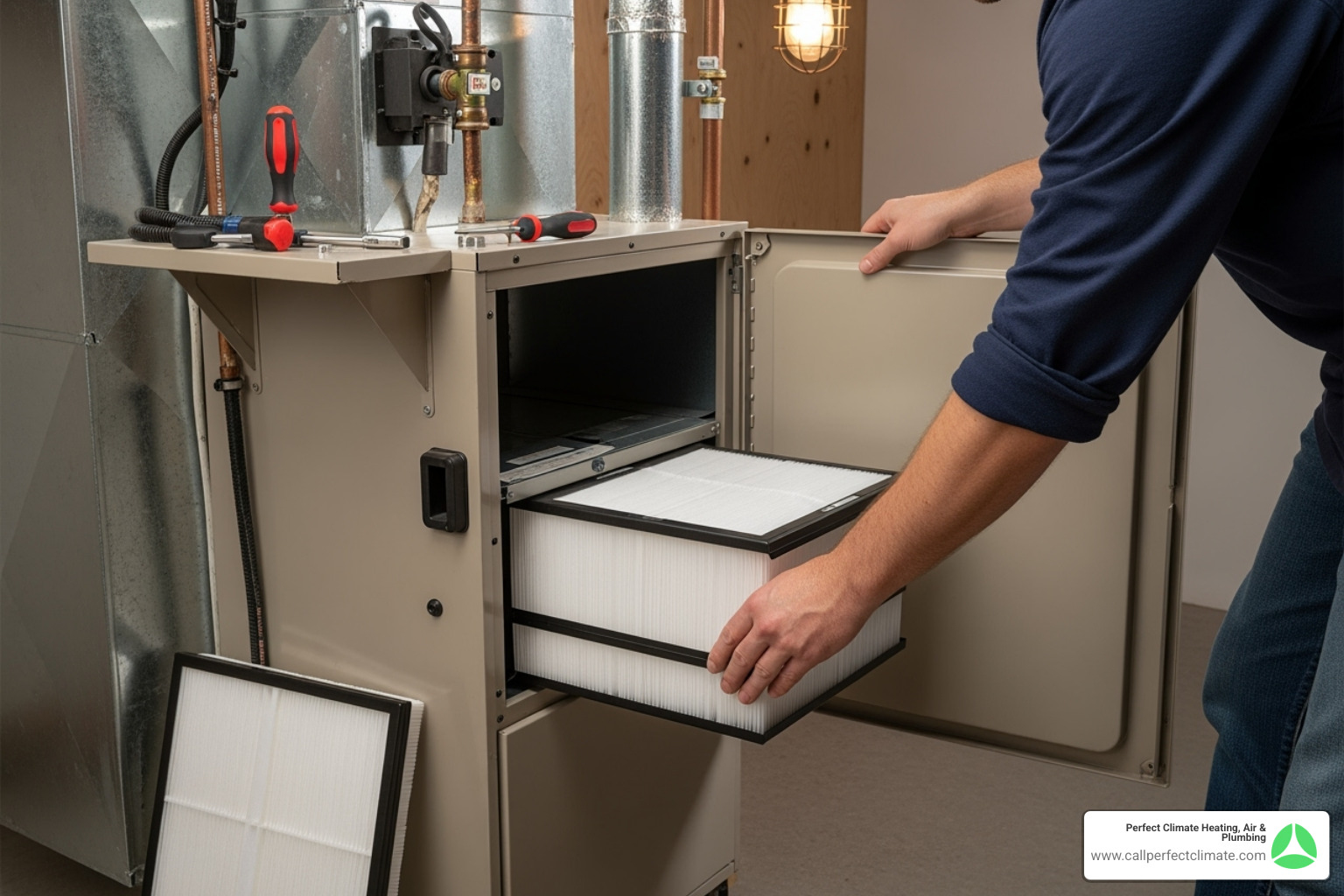Why Your Home’s Air Circulation System Needs Regular Attention
Clean air vents house maintenance is essential for optimal HVAC performance and healthy indoor air quality. Your home’s air recirculates through the HVAC system an average of five to seven times per day, meaning any dust, debris, or contaminants in your vents get blown throughout your living space repeatedly.
Quick Answer: When to Clean Your Air Vents
- Visible signs: Dark rings around vents, dust buildup, or debris
- Air quality issues: Musty odors, increased allergy symptoms, or stale air
- HVAC problems: Reduced airflow, inconsistent temperatures, or higher energy bills
- After events: Home renovations, pest infestations, or suspected mold growth
- Routine maintenance: Every 6 months for surface cleaning, annually for deep cleaning
Just as all surfaces in your home collect dust over time, your air ducts accumulate the same buildup – but with a bigger impact. In a typical six-room home, up to 40 pounds of dust is created annually through everyday living. When your vents are clogged with dust, pet dander, and debris, your HVAC system works harder to circulate air, leading to higher energy costs and potential system damage.
The good news? Most homeowners can handle basic vent cleaning themselves with simple tools and techniques. However, knowing when to clean versus when to call professionals can save you money, protect your health, and keep your HVAC system running efficiently for years to come.
Telltale Signs: Is It Time for an Air Duct Cleaning?
Your home has a way of telling you when something needs attention – and your air vents are no exception. Learning to recognize these warning signs can help you maintain better clean air vents house conditions and decide whether you can handle the job yourself or need to call in the professionals.
The most obvious red flag is visible dust buildup around your vents. Take a peek at those vent covers, especially the return air vents where your system draws air in. If you spot thick layers of dust, pet hair, or dark rings forming around ceiling vents, that’s your home’s way of saying “help!” This visible grime isn’t just an eyesore – it’s a preview of what’s probably building up deeper in your ductwork.
Your nose knows when something’s wrong too. Musty odors wafting from vents when your HVAC kicks on often signal moisture problems or stagnant debris lurking in the ducts. Nobody wants their living room smelling like a damp basement when the air conditioning starts up!
Pay attention to how your family feels at home. If everyone’s suddenly dealing with increased allergy symptoms like persistent coughing, sneezing, or itchy eyes without an obvious cause, dirty vents could be the culprit. Dust, pollen, and pet dander get trapped in ducts and then blow around your home on repeat, making life miserable for sensitive family members.
Inconsistent airflow is another telltale sign. When some rooms feel stuffy while others are perfectly comfortable, or when barely any air comes from certain registers, debris might be blocking proper circulation. Your HVAC system is doing its best, but it’s fighting an uphill battle against clogged ducts.
Recent home events matter too. Post-renovation dust is notorious for settling into ductwork, even when contractors take precautions. Construction creates an incredible amount of fine particles that love to hide in your ventilation system long after the project wraps up.
Don’t ignore signs of pest infestation either. Finding evidence of rodents or insects in or around your vents means they’ve likely made themselves at home in your ductwork. Where pests go, droppings and debris follow.
For a comprehensive look at these warning signs, it’s helpful to understand all the indicators that point to dirty ducts.
When Cleaning is Non-Negotiable
Some situations go beyond routine maintenance – they’re urgent health and safety concerns that demand immediate professional attention. These aren’t just suggestions; they’re non-negotiable scenarios where DIY simply won’t cut it.
Substantial visible mold tops this list. If you actually see mold growing inside your ducts or on HVAC components, stop everything and call professionals immediately. Mold spores spread rapidly through ventilation systems, creating serious health risks for your entire family. Wet or moldy insulated ducts can’t be cleaned effectively – they need complete removal and replacement. Fixing the underlying moisture problem is just as important as cleaning up the mold.
Vermin infestation requires professional intervention too. Finding rodents, insects, or other unwelcome guests in your ductwork means dealing with droppings, nesting materials, and potentially deceased critters contaminating your air system. After pest control handles the invasion, professional duct cleaning is essential to eliminate their contaminated legacy and any lingering bacteria or odors.
Excessive debris post-renovation goes beyond what DIY cleaning can handle. While surface dust from minor projects might be manageable, major construction or remodeling can pack your ducts with plaster dust, sawdust, and debris that requires professional-grade equipment to remove safely and completely.
Unexplained respiratory issues affecting family members should raise immediate red flags. If people in your home develop new breathing problems, persistent coughs, or allergy-like symptoms without clear external causes, contaminated ductwork could be a major contributor. This isn’t the time to experiment with DIY solutions.
These critical situations highlight when it’s truly time for air duct cleaning by certified professionals who can safely restore your home’s air quality and protect your family’s health.
The Health and Home Benefits of Clean Vents
When you take the time to clean air vents house properly, you’re not just checking off another item on your home maintenance list. You’re actually investing in your family’s health, your home’s comfort, and yes—even your monthly budget. Let’s explore why this simple task packs such a powerful punch.
The most important benefit is improved indoor air quality. Think about it this way: your air ducts are like the lungs of your home, and just like our lungs, they need to stay clean to work properly. When ducts are filled with dust, allergens, pet dander, mold spores, and other microscopic hitchhikers, these unwanted guests get a free ride throughout your entire house—over and over again. Clean vents dramatically reduce these airborne pollutants, giving you fresher, cleaner air to breathe.
This improvement in air quality often leads to noticeable allergy and asthma relief for family members. By removing common triggers like pollen, dust mites, and pet dander from your home’s circulation system, you create a much more comfortable environment for anyone with respiratory sensitivities. We’ve heard from countless homeowners who were amazed at how much better they felt after their vents were properly cleaned. The impact of clean ducts on health can be truly life-changing for sensitive individuals.
Another welcome surprise is odor removal. You know those persistent musty, stale, or mysterious smells that seem to follow you from room to room? Often, they’re originating from accumulated debris in your ductwork. Dust, mold, and other buildup can create unpleasant odors that get distributed throughout your home every time the system runs. A thorough cleaning eliminates these odor sources at their root, leaving your home smelling genuinely fresh.
But the benefits extend beyond health and comfort—they reach right into your wallet too. Clean vents lead to improved HVAC efficiency. When your ducts are clogged with debris, your heating and cooling system has to work significantly harder to push conditioned air through those restricted pathways. It’s like trying to breathe through a straw versus breathing normally.
This improved efficiency translates directly to lower energy costs. According to the U.S. Department of Energy, 25 to 40 percent of the energy used for heating or cooling a home is wasted due to inefficiencies, and dirty air ducts are a major culprit. When you remove these obstructions, your system can operate more freely, and you’ll likely notice the difference on your utility bills.
Finally, maintaining clean vents contributes to an extended system lifespan. The constant strain of pushing air through dirty, clogged ducts puts unnecessary stress on your HVAC components, particularly the blower motor. By ensuring smooth airflow, you reduce wear and tear on your equipment, potentially saving yourself from costly repairs or premature system replacement down the road.
These benefits show why paying attention to your air vents isn’t just about cleanliness—it’s about creating a healthier, more comfortable, and more efficient home for your family.
Your DIY Guide to Clean Air Vents House
Rolling up your sleeves for some clean air vents house maintenance? You’re in for a surprisingly satisfying project! While DIY cleaning won’t match the thoroughness of professional equipment, it’s absolutely perfect for regular upkeep and surface-level cleaning that keeps your home’s air circulation system running smoothly between professional services.
Think of it this way: just like you wouldn’t skip vacuuming your floors until they needed professional carpet cleaning, your vents benefit from regular attention too. The best part? Most homeowners can tackle this project with tools they already have lying around the house.
Tools and Materials You’ll Need
Before we dive into the fun stuff, let’s make sure you’re properly equipped. The good news is that most of these items are probably already in your cleaning closet or toolbox.
A vacuum cleaner with hose and brush attachments is your best friend here. A shop vacuum with a long hose gives you the best suction and reach, but don’t worry if you only have a regular household vacuum – it’ll do the job for surface cleaning. You’ll also need a screwdriver or Allen wrench that matches the screws on your vent covers. Pro tip: check a few vents first to see which type you need!
For the actual cleaning, grab a soft-bristle brush with a long handle. A toilet brush works perfectly (please use a new, clean one!), or you can invest in a specialized vent brush if you’re feeling fancy. Microfiber cloths are fantastic for wiping down surfaces and actually trapping dust instead of just moving it around.
Don’t forget warm soapy water for giving those vent covers a proper bath, and most importantly, protective gloves and a mask. Trust us on this one – you don’t want to be breathing in all that dust you’re about to disturb, especially if you have allergies.
Step-by-Step: How to Clean Air Vents House
Now comes the satisfying part! Here’s your roadmap to cleaner vents and fresher air.
Start by turning off your HVAC system completely. This isn’t just a safety thing (though it definitely is that) – it also prevents you from accidentally pushing dust deeper into your system while you’re working. Hit the “off” switch on your thermostat, and if you want to be extra cautious, you can flip the breaker too.
Next, remove those vent covers. Carefully unscrew each cover and set the screws aside in a small container. You’d be amazed how quickly those little screws can disappear into the carpet! This is often when homeowners get their first real look at how much dust has actually accumulated.
Time for the vent covers to get a spa day. Take them outside or to a utility sink and give them a good brushing to remove loose dust. Then wash them thoroughly with warm, soapy water. You’ll probably be surprised at how much brighter and cleaner they look! Let them dry completely before moving to the next step.
Now for the main event – cleaning inside the ducts. Using your vacuum’s hose and brush attachment, reach as far as you comfortably can into each duct opening. You’ll be amazed what comes out – dust bunnies, pet hair, and if you have floor vents, maybe some “treasures” like small toys or coins that have fallen through over the years.
Follow up with a gentle wipe-down of the visible interior surfaces. Wrap a slightly damp microfiber cloth around your long-handled brush and carefully clean what you can reach. Don’t force anything or push too hard – you’re just getting what the vacuum left behind.
Once everything is clean and dry, reattach the covers securely. Make sure they’re properly aligned and all screws are snug. Finally, turn your HVAC system back on and enjoy that first breath of cleaner air circulating through your home.
This approach gives you a solid foundation for maintaining your clean air vents house between professional cleanings. For more detailed information about comprehensive cleaning methods, you can consult professional resources or our expert team. Consistency is key – a little regular attention goes a long way toward keeping your home’s air fresh and your system running efficiently!
DIY vs. Professional Cleaning: Knowing When to Call the Experts
Let’s be honest – we all love a good DIY project! There’s something satisfying about rolling up your sleeves and tackling home maintenance yourself. But when it comes to keeping your clean air vents house in top shape, it’s important to understand when your trusty vacuum and elbow grease are enough, and when it’s time to bring in the cavalry.
Think of it like taking care of your teeth. You brush daily at home (that’s your DIY vent cleaning), but you still need to see the dentist for professional cleanings that address hard-to-reach spots and deeper issues. Both are important, but they serve very different purposes.
Your DIY efforts are fantastic for surface-level maintenance. You can easily tackle visible dust on vent covers, clear out obvious debris, and keep things looking fresh between professional services. It’s cost-effective since you’re using tools you likely already own, and you can knock it out in a few hours on a weekend afternoon.
However, DIY cleaning has some real limitations that are worth understanding. Your household vacuum, while great for carpets and furniture, simply doesn’t have the muscle to reach deep into your ductwork. Those twists, turns, and narrow passages that snake through your walls? Your vacuum hose can only go so far, leaving significant portions of your duct system untouched.
Professional cleaning, on the other hand, is like bringing in the heavy artillery. We use powerful negative pressure vacuums – think industrial-strength equipment that creates suction many times stronger than your home vacuum. Combined with specialized tools like air whips and rotary brushes, we can dislodge and remove contaminants from every corner of your system.
Here’s where things can get tricky with DIY approaches: improper techniques can backfire. Without the right equipment, you might accidentally push debris deeper into your ducts, creating new blockages. Older or flexible ductwork can be damaged by aggressive brushing or inappropriate tools, leading to air leaks that reduce efficiency and increase your energy bills.
Professional equipment creates what we call “source removal” – we create powerful suction at one end while loosening debris at the other, ensuring everything gets captured rather than scattered around your home. It’s a comprehensive approach that includes cleaning your HVAC components, not just the visible vents. Understanding the importance of professional duct cleaning helps explain why this thorough approach matters so much for your home’s air quality.
When Professional Help is Essential
While we absolutely encourage regular DIY maintenance for your clean air vents house, there are definitely times when calling professionals isn’t just recommended – it’s essential for your family’s health and safety.
Deep contamination is one clear signal. If you’re seeing years of accumulated buildup, especially in older homes, or if dust is visibly blowing from your vents when the system runs, household equipment simply won’t cut it. We have the power to reach and remove even the most stubborn debris that’s been building up over time.
Suspected mold growth is absolutely non-negotiable territory for professionals. Mold isn’t just unsightly – it’s a serious health hazard. Attempting to clean mold yourself without proper containment can actually spread spores throughout your entire home, making the problem exponentially worse. We have specialized techniques and safety protocols to address mold properly.
After dealing with pest removal aftermath, professional cleaning becomes crucial. Rodents, insects, and other unwelcome guests leave behind more than just memories – they leave nests, droppings, urine, and lingering odors that can harbor bacteria. Our thorough cleaning eliminates all traces of their unwelcome visit.
If your home has fragile or older ductwork, professional expertise becomes invaluable. Different duct materials require different approaches, and improper DIY techniques can easily cause tears or damage that lead to expensive repairs. Our technicians assess your specific system and use appropriate methods to protect your investment.
Finally, when you want a guaranteed thorough job following industry standards, professional service delivers peace of mind. Organizations like NADCA (National Air Duct Cleaners Association) set rigorous standards for assessment, cleaning, and restoration of HVAC systems. When you choose certified professionals, you’re investing in expertise that ensures your entire system – not just the visible parts – gets the attention it deserves. You can Find a NADCA professional duct cleaner near you.
The bottom line? DIY maintenance is wonderful for keeping up with regular cleaning, but when serious issues arise, professional intervention protects both your health and your home’s systems.
Long-Term Prevention: Keeping Your Ducts Cleaner for Longer
Once you’ve achieved that satisfying clean air vents house feeling, you’ll want to savor it as long as possible! The secret isn’t just in the initial cleaning – it’s in the smart prevention strategies that keep dust, debris, and allergens from building up again. Think of it like maintaining a freshly detailed car; with the right habits, you can keep that “just cleaned” feeling going strong.
The beauty of preventative maintenance is that small, consistent efforts save you from bigger headaches down the road. Instead of dealing with heavily contaminated ducts every few years, these simple practices help maintain cleaner air circulation year-round.
The Critical Role of Air Filters
Your HVAC air filter is like a bouncer at an exclusive club – it decides what gets into your ductwork and what stays out. This humble component is arguably your most powerful tool for maintaining a clean air vents house.
Filter efficiency makes all the difference, and that’s where MERV ratings come in. These ratings range from 1 to 20, with higher numbers capturing smaller particles. A MERV 8 filter catches dust and pollen, while a MERV 11 can trap pet dander and some mold spores. However, don’t assume higher is always better – your HVAC system needs adequate airflow, so check your owner’s manual before upgrading to a very high MERV filter.
The most critical habit? Regular filter replacement. A clogged filter is essentially useless, allowing dust and debris to bypass it entirely and settle into your freshly cleaned ducts. We recommend changing standard 1-inch filters every month to three months, depending on your household. Have pets? Change them monthly. Live alone with minimal dust? Every three months might work. Thicker 4-inch filters can often last up to six months.
Proper filter fit matters more than you might think. Even a small gap around the edges allows unfiltered air to sneak past, carrying dust directly into your system. Take a moment to ensure your filter sits snugly in its housing – no shortcuts here!
By staying on top of filter changes, you’re essentially preventing contaminants from entering your ductwork in the first place. It’s much easier to trap dust in a $15 filter than to remove it from your entire duct system later. For professional filter service and maintenance, consider our expert services.
Preventative Maintenance to Keep Your Clean Air Vents House Fresh
Beyond filters, several other smart practices work together to maintain cleaner ducts and better indoor air quality. These aren’t complicated – just consistent habits that make a real difference.
Annual HVAC inspections are like regular check-ups for your home’s breathing system. During these visits, our technicians can spot potential issues like small duct leaks, moisture problems, or component wear before they become bigger problems. It’s preventative care that pays dividends.
Sealing ductwork leaks is often overlooked but incredibly important. Those small gaps and cracks in your ducts don’t just waste energy – they also pull in dusty, unfiltered air from attics, basements, and crawl spaces. Sealing these leaks keeps your ducts cleaner and your energy bills lower. Win-win!
Here’s a simple tip that works wonders: using doormats. Heavy-duty mats at every entrance trap dirt and debris before it gets tracked through your home. Less dirt on your floors means less dust getting pulled into your return vents.
Regular dusting and vacuuming might seem obvious, but it directly impacts your duct cleanliness. Focus especially on areas near your return vents – that’s where airborne dust gets pulled into your system. A vacuum with a HEPA filter captures those tiny particles that regular vacuums just blow around.
Finally, humidity control plays a bigger role than many homeowners realize. Keeping indoor humidity between 30% and 50% prevents mold and mildew growth in your ducts. Here in southern Indiana, our summers can get pretty humid, so proper moisture control is essential for maintaining that clean air vents house environment.
These preventative steps are all part of the benefits of regular ductwork cleaning that smart homeowners enjoy. With consistent attention to these details, you’ll extend the time between major cleanings and breathe easier knowing your home’s air is as fresh as possible.
Conclusion
Your journey to achieving and maintaining a clean air vents house doesn’t have to be overwhelming. Throughout this guide, we’ve uncovered the telltale signs that your ducts need attention, explored the remarkable health and home benefits of clean ventilation, and walked through both DIY approaches and when professional help becomes essential.
The truth is, clean air ducts are about so much more than just removing visible dust. They’re about creating a healthier environment for your family, reducing those persistent allergy symptoms, and helping your HVAC system work smarter, not harder. When your vents are clean, you’re not just improving air quality – you’re potentially lowering your energy bills and extending the life of your entire heating and cooling system.
Regular maintenance, from changing filters to recognizing when deeper cleaning is needed, becomes second nature once you understand the signs. And remember, while DIY cleaning has its place in your home maintenance routine, some situations absolutely require professional intervention. Mold growth, pest infestations, and extensive contamination aren’t just inconveniences – they’re health concerns that demand expert attention.
At Perfect Climate Heating, Air & Plumbing, we’ve been helping families throughout Haubstadt, IN and surrounding communities like Evansville, Princeton, and Newburgh breathe easier for years. We understand that your home’s air quality directly impacts your family’s comfort and well-being. Our team uses advanced equipment and follows industry best practices to ensure your ductwork gets the thorough cleaning it deserves.
Your home’s air circulation system works hard every single day, quietly moving conditioned air throughout your living spaces. Doesn’t it deserve the same care and attention you give to other important systems in your home?
Don’t wait until poor air quality affects your family’s health or your energy bills start climbing. Take that proactive step toward cleaner, healthier indoor air today. Schedule your professional air duct cleaning service today and find what truly fresh, clean air feels like in your home.




